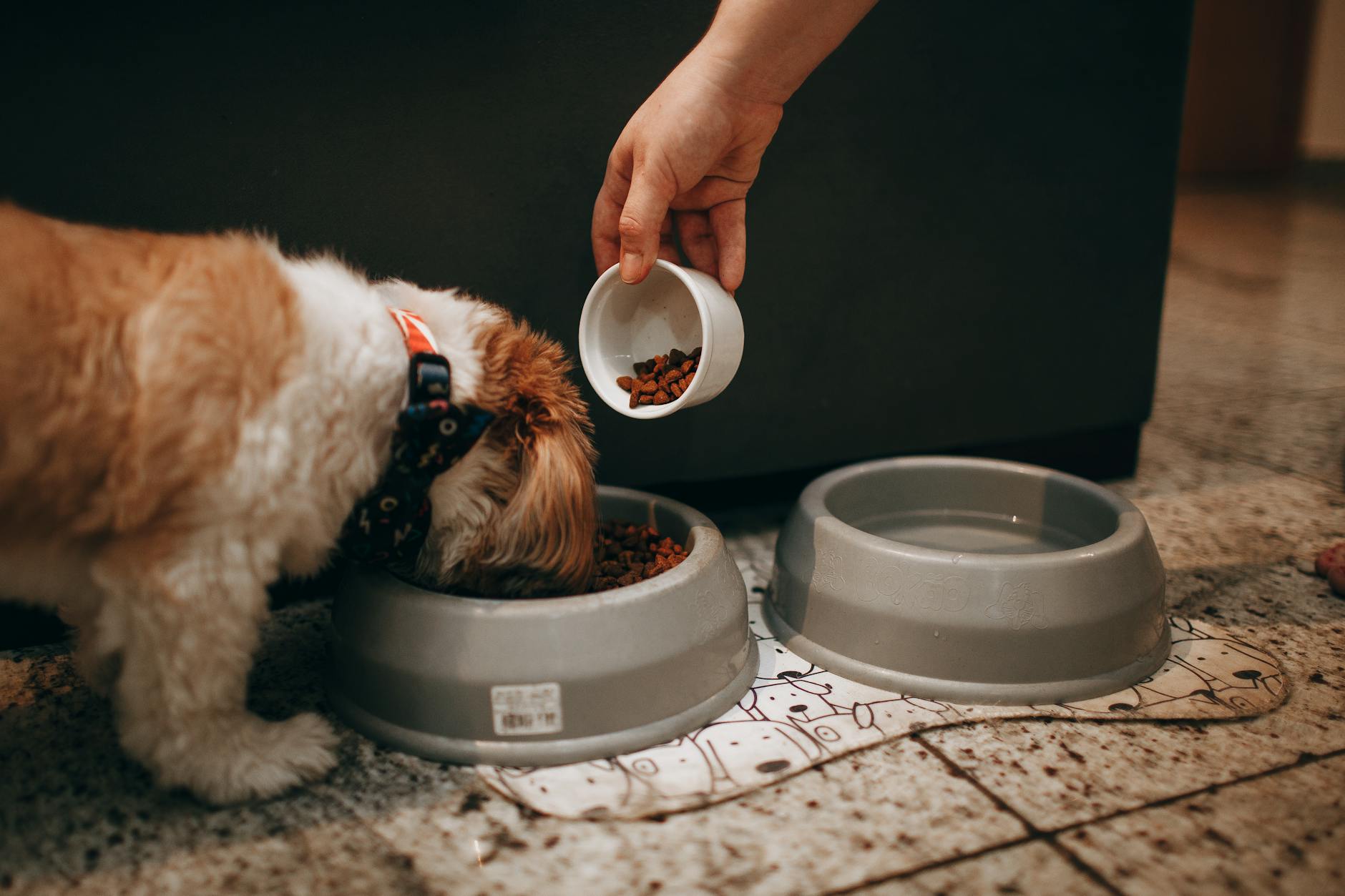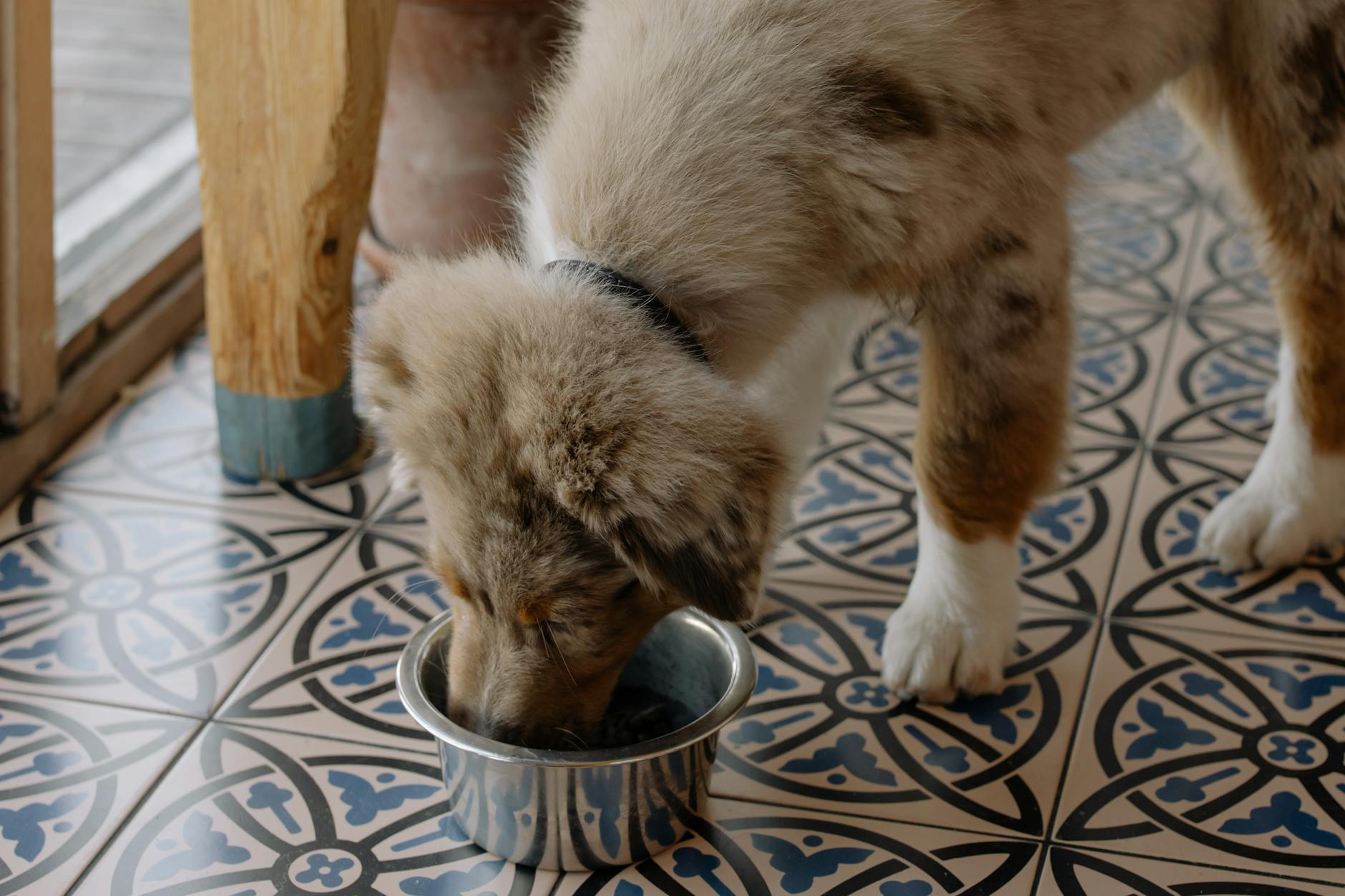Puppy Feeding Schedule That Works: My Guide to Healthy Dogs and Happy Training
Puppy Feeding Schedule That Works: My Guide to Healthy Dogs and Happy Training . When I first brought Savannah home, I quickly learned that a clear puppy feeding schedule does much more than keep her tummy full.
A set routine helps with her healthy growth, keeps her energy balanced, and makes dog obedience training much smoother. If you’re a dog owner like me, you’ve probably wondered how to find a schedule that actually works day in and day out.
It can be tricky figuring out the best feeding approach with so many dog breeds and dog food options out there. Sticking to a plan not only supports your puppy’s health but can also reduce unwanted behaviors, making both training and mealtime more enjoyable.
Over time, I’ve found that a thoughtful routine helps Savannah thrive and lets me focus on what matters most—her happiness.
If you’re feeling overwhelmed with all the dog food reviews and online dog training advice, you’re in the right place. I’ll walk you through building a schedule that fits your puppy’s needs and lifestyle.
And if you want to learn how feeding routines can affect long-term health, you might find some helpful notes in the Boston Terrier Health Concerns guide. Let’s get started so your dog can enjoy every meal and every training session.
Table of Contents
Key Takeaways
A strong puppy feeding schedule lays the groundwork for your pup’s lifelong health, happiness, and good behavior. When I set up Savannah’s routine, it transformed more than just her meals. It helped with her growth, dog obedience training, and even her energy around the house.
Let’s look at the main lessons you can take from creating a schedule that actually works, no matter your puppy’s breed or your daily routine.
 Photo by Kampus Production
Photo by Kampus Production
Consistency Makes All the Difference
- Puppies thrive on routine, just like kids do. Feeding your puppy at set times each day helps them understand when to expect food and makes bathroom breaks easier to predict. This steady rhythm often means fewer accidents and a smoother path with dog obedience training.
- A regular schedule also helps you spot problems, like skipped meals or sudden changes in appetite, which could point to health issues. Timely catch-ups mean faster solutions.
Choose the Right Dog Food for Growth
- Not all puppy food is the same. The right food supports your dog’s developing body, sharp mind, and busy lifestyle. Stick with high-quality, age-appropriate options and always check trusted dog food reviews before buying new brands.
- Every breed, from the tiniest Chihuahua to an energetic Goldendoodle, has specific needs. What worked for Savannah might not be right for another puppy. Pay attention to guidance on puppy feeding schedules and look up breed-specific advice when you’re not sure. I like to reference in-depth guides like those found in this puppy feeding schedule resource.
Feeding Schedule Supports Better Dog Training
- Training a puppy isn’t just about commands; it’s about building good habits around everything your dog does, eating included. Consistent mealtimes make it easier to train for potty breaks and minimize begging at the table.
- For me, sticking to Savannah’s feeding schedule became the backbone of our dog trainig sessions. She learned to expect structure from me, which improved her focus during any training activity and cut down on the chaos.
Monitor and Adjust as Your Puppy Grows
- Puppies change fast. As they grow, their feeding needs will shift. Younger puppies might eat three or four times a day, but older puppies can be happy with just two meals.
- Keep an eye on your pup’s body condition, mood, and bathroom habits. If something shifts, talk with your vet, check reliable resources, or explore more insights on adjusting feeding routines from trusted sources, such as this guide to how much should I feed my dog.
Leverage Online and Peer Advice
- The amount of advice out there on online dog training can feel overwhelming. Focus on tips that match your dog’s breed and your family’s lifestyle.
- Checking in with other dog owners and reading expert insights helps you make better choices along the way. Don’t be shy about seeking out breed and age-specific tips or asking your vet for feedback.
By keeping these takeaways in mind, you can build a puppy feeding schedule that not only supports healthy growth but also leads to a happier, smarter, and more well-behaved dog. Just like Savannah, your puppy will thrive with the right routine combined with patience and love.
Why a Consistent Puppy Feeding Schedule Matters
When I first set a puppy feeding schedule for Savannah, I realized I was creating a solid foundation for her health, happiness, and learning.
Consistency isn’t just about filling the food bowl at the same time, it shapes everything from strong bones to smart training. Just like kids who eat and nap on a schedule, puppies feel safer and grow better with predictable routines.
Supporting Healthy Growth and Digestion
 Photo by Sarah Chai
Photo by Sarah Chai
During puppyhood, your dog’s muscles, bones, and organs are all developing fast. Missing meals or eating at odd times can disrupt this delicate process. When Savannah was young, sticking to a regular puppy feeding schedule meant her body always had the fuel needed for play and growth spurts.
Key reasons routine feeding boosts healthy development include:
- Optimized muscle and bone growth: Predictable nutrition helps puppies absorb nutrients more efficiently.
- Steady digestion: Puppies aren’t built for grazing. Scheduled meals help avoid stomach upset, diarrhea, and unpredictable energy crashes.
- Better appetite control: Regular meals mean they eat the food they need—not too much, not too little.
For extra tips on balancing meals for different dog breeds and growth stages, you can dive into detailed resources like Puppy Feeding Fundamentals.
Prevention of Obesity and Associated Risks
Feeding puppies ad libitum, or letting them eat whenever, can lead to overfeeding and weight gain. Obesity in puppies isn’t just about looks—extra weight strains growing joints, slows movement, and can set your pup up for health trouble down the road.
By following a thoughtful puppy feeding schedule, you help prevent:
- Excess calorie intake: Scheduled meals reduce the temptation to overfeed.
- Begging and scavenging: Puppies are less likely to beg at the table or snatch food when there’s a set routine.
- Obesity-related issues: Breeds like Boston Terriers are prone to health risks when overweight. Read about Boston Terrier Health Concerns to see just how important healthy feeding routines are in practice.
Many dog food reviews highlight the risks of overfeeding, but a schedule transforms theory into action. Sticking to a routine encourages portion control and builds long-term good habits, no matter your pup’s breed.
Puppy Feeding Schedules and Dog Obedience Training
Savannah learned early that meal times come with a set of simple expectations. Consistent feeding provided teachable moments for basic commands like “sit” and “wait.” It also gave me a clear structure for house training and built her trust in daily routines.
A regular puppy feeding schedule lays strong groundwork for:
- Predictable potty breaks: It’s easier to time bathroom trips when meals are on the clock.
- Smoother training sessions: When puppies know what to expect, they’re calmer and more open to learning.
- Stronger bond: Dogs thrive with positive, predictable leadership. Mealtime structure sets the tone for all other routines, including dog obedience training and walks.
If you want a detailed look at building a daily training flow, check out this detailed training schedule for at-home dog training. Good schedules make dog trainig more successful and your puppy more confident. For more advice on dog breeds, food, and routines, you can explore my favorite in-depth guides at K9Nutripick’s puppy feeding schedule resource.
A thoughtful, steady routine turns chaos into calm—both at the dinner bowl and throughout your puppy’s day.
How to Determine the Right Puppy Feeding Schedule for Your Dog
Setting up the right puppy feeding schedule is about more than picking meal times. It’s about tuning in to your dog’s breed, age, lifestyle, and health. When I worked out Savannah’s routine, I realized just how much her needs changed based on her size, energy, and growth stage.
Let’s dig into how to personalize feeding from all angles so your puppy gets what they need to thrive.
Small vs. Large Dog Breeds
Small and large dog breeds need very different feeding schedules. Tiny puppies, like Chihuahuas or Yorkies, have fast metabolisms and small stomachs. They burn energy quickly and can’t eat too much at once, so I recommend three to four small meals a day at regular intervals.
This prevents low blood sugar and keeps their energy up for play and training.
Large breeds, like Labs or Great Danes, need fewer but hearty meals. They grow fast, putting stress on bones and joints. Overfeeding, especially in a single meal, can put them at risk for bloat—a serious health concern. Two to three balanced meals a day work well for bigger pups.
Here’s a quick summary:
- Small breeds: 3-4 small meals daily
- Large breeds: 2-3 carefully measured meals daily
Every breed has unique needs, though. Interested in how feeding routines can vary even more? Dive into these 10 Fascinating Facts About Akita Dogs. You’ll see how certain breeds have feeding quirks based on their background and personality.
Factoring in Age and Developmental Stages
 Photo by James Goddard
Photo by James Goddard
As your puppy grows, their feeding schedule will change. Here’s what I learned during each stage with Savannah:
- Puppy (0-4 months): Young puppies need to eat often—usually 4 times a day. Their bodies are growing fast and they need a steady stream of calories and nutrients.
- Adolescent (4-12 months): At this stage, you can often move to 3 meals a day. Puppies are still growing, but their bodies can process slightly larger meals and wait longer between feedings.
- Adult (1 year+): Most mature dogs do well on two meals a day, unless your vet or breeder suggests otherwise due to breed or health reasons.
Moving from four meals a day down to two isn’t just about convenience. It reflects your puppy’s slower metabolism and a decrease in growth rate. Keep those transitions gradual. Always watch your dog’s weight, mood, and stool quality when you change the schedule.
Adjusting for Activity Level and Special Needs
Some dogs are little dynamos. Savannah has always been one of those pups who never seems to sit still. Energetic or working dogs burn calories faster, even as puppies. They need a bit more fuel to keep up, spread across an extra meal or slightly larger portions at feeding time.
For dogs with special needs (think allergies, medical conditions, or weight management issues), custom puppy feeding schedules make a huge difference. Dogs recovering from illness, managing chronic conditions, or struggling with weight might need smaller, more frequent meals of a specific dog food.
Consider these steps for tailoring the schedule:
- Watch your dog’s energy and appetite each day
- Read dog food reviews to choose the right type for their needs
- Talk with your vet for advice, especially for health challenges
- Explore advice from dog trainig programs and online dog training communities for meal-based routines
No matter your dog’s activity level or special needs, don’t be afraid to adjust. The best puppy feeding schedule combines structure and flexibility based on what your dog shows you each day. Every pup is unique, and finding the right rhythm will help yours (and mine, like Savannah) grow up healthy, happy, and well-behaved.
Choosing the Right Dog Food and Portion Sizes
Choosing what goes into your puppy’s bowl is just as important as when you serve it. When I brought Savannah home, I quickly noticed that picking the right dog food set the stage for her energy levels, growth, and even her temperament. Pairing good food with the right portions shapes your puppy’s future.
Below, I’ll break down what makes a food truly high quality and flag the mistakes that can throw off your puppy feeding schedule.
Evaluating Puppy Dog Food Quality: Discuss ingredients to look for in high-quality puppy food.
 Photo by Helena Lopes
Photo by Helena Lopes
Puppies need food that matches their quick growth and exploring nature. Not all foods are created equal—some help your dog thrive, others can slow them down. I check ingredients the same way I check labels for myself.
Here’s what I look for in high-quality puppy food:
- Real animal protein as the first ingredient
Named meats like chicken, beef, lamb, or fish should lead the list. Protein powers muscle and organ growth. - Whole grains or healthy carbs
Look for brown rice, sweet potatoes, or oatmeal. They supply energy without causing big sugar swings. - Healthy fats
Chicken fat, fish oil, or flaxseed give puppies fatty acids for brain and coat health. - Essential vitamins and minerals
Puppy food should include calcium, phosphorus, DHA and antioxidants for bones, teeth and immune health. - No artificial preservatives or colors
I avoid foods full of chemicals, fake colors, or added sugars.
Some brands use fancy packaging and buzzwords, but the real story is in the ingredient list. For a deeper look, check out these dog food ingredients to look for (and avoid) to help make smart choices for your puppy feeding schedule.
Every dog is unique. Some breeds, like Goldendoodles or Bulldogs, have special dietary needs. I find it helpful to reference breed-specific nutrition guides and trusted dog food reviews for more pointers.
Frequent Feeding Mistakes to Avoid: List common errors in selecting or serving dog food that can disrupt growth and behavior.
The wrong food or wrong portion can upset your puppy’s stomach, energy, and even mood. I’ve made some of these mistakes with Savannah before finding what works best for her. Learning from my own blunders (and others’ advice) saves a lot of stress.
Here are common puppy feeding mistakes to watch for:
- Guessing portions rather than measuring
Overfeeding adds pounds fast, underfeeding can slow growth. Always use a measuring cup based on the bag or your vet’s advice. - Switching foods too quickly
Sudden changes can upset digestion. If you need to change brands or recipes, do it gradually over a week. - Treats as a meal substitute
Treats are fun, but too many can cause picky eating and weight problems. Stick to treats making up no more than 10% of total calories. - Ignoring “Life Stage” labels
Food for “all life stages” can be confusing. Puppies need formulas designed for growth, not adult maintenance. - Letting puppies free-feed
Leaving food out all day makes it hard to track intake and can lead to accidents or obesity. - Choosing food for convenience over quality
While convenience matters, always check that food matches your puppy’s needs, breed, and growth rate.
For a full list of top feeding errors (and smart ways to sidestep them), see this resource on common feeding mistakes. These pitfalls disrupt healthy growth and can ripple into dog obedience training, making routines and commands harder for both you and your puppy.
If you want help picking the best food for specific dog breeds, look through the guides on the best food for Goldendoodles or other popular pups. And for those venturing into online dog training courses, a healthy, steady puppy feeding schedule is your first partner in building better behavior.
Keeping the right foods and portions front and center means a healthy dog with the energy and focus for anything—whether it’s a walk around the block or a brand-new dog trainig session.
Tips for Creating and Maintaining an Effective Puppy Feeding Schedule
Building a strong puppy feeding schedule isn’t just about filling a bowl—it’s about creating habits that help dogs grow healthy and happy. With Savannah, I quickly saw how a thoughtful schedule paid off in her energy, focus during dog obedience training, and smooth transitions between play, eats, and sleep.
Below are two big ideas that help tie your pup’s meals into daily life and make sure your routine keeps working as your dog grows.
Aligning Mealtime With Online Dog Training and Play
 Photo by cottonbro studio
Photo by cottonbro studio
When I started dog obedience training with Savannah, I learned that meals can be your secret tool for better focus and happier learning. The trick is to link feeding times with short training sessions or active play. A little structure before and after meals goes a long way:
- Use meal routines as training rewards. Practicing commands like “sit,” “wait,” or “leave it,” right before eating lets your puppy connect good behavior with positive outcomes. I always had Savannah “wait” for her bowl and it made her calmer throughout the day.
- Schedule play and activity before meals. A good play session or a short walk before mealtime helps burn off excitement. Savannah is way more relaxed and eats slowly if she’s had a quick run around the yard first, making digestion easier, too.
- Avoid heavy play right after eating. To prevent tummy aches or bloat, let your puppy rest for at least 30-60 minutes after meals, especially if you have an active or large-breed dog.
Learning from other dog breeds can also shape your routine for the better. For example, Boxers are known for their playful spirit and stamina but do best with structured meals and training blocks, not random snacks. Understanding breed-specific routines—as described in this Boxer dog traits overview—will help you get timing right for your own pup.
With so many dog breeds and dog food options, it’s smart to read real dog food reviews and chat with online dog training groups to see what works for similar dogs. Community tips were a big help during Savannah’s puppyhood.
Tracking Progress and Making Adjustments
An effective puppy feeding schedule isn’t set in stone. As your puppy grows, their needs will change—sometimes fast! Keeping track of your dog’s health and progress helps you know when to tweak meal sizes or times.
Here’s what I do to keep Savannah’s schedule dialed in:
- Monitor weight and body shape weekly. I check Savannah’s ribs and waist, making sure she’s growing but not getting chubby. Vets often use body condition charts to teach healthy weight for all dog breeds.
- Watch stool quality and energy levels. Healthy puppies have regular bowel movements, shiny coats, and steady moods. Odd bathroom trips, listlessness, or bursts of hyperactivity could mean it’s time to revisit meal portions or food brands.
- Adjust portions as your dog matures. Puppies burn calories fast, but as they approach one year, growth slows and meal sizes should as well. Phase from three or four meals a day to two, following advice from trusted sources or your vet.
If you’re switching dog food or seeing sudden shifts in appetite, do it gradually and keep an eye on changes. Never hesitate to reach out to an online dog training community, or check dog food reviews for others’ feedback. For more on monitoring your puppy’s well-being and adapting routines, the guides at K9Nutripick are a reliable fallback.
The most effective puppy feeding schedule mixes regular meals, play, and positive training moments—all watched closely and tweaked when you spot a change. This way, your dog gets the right balance at every stage, making for a happier, healthier companion.
Frequently Asked Questions About Puppy Feeding Schedules
Sorting through the basics of a puppy feeding schedule can leave any dog owner with plenty of questions. I know when Savannah first came home, I spent hours searching for answers about portions, meal times, dog food choices, and how to align everything with dog obedience training.
Here, I break down the most common questions I’ve tackled myself, with useful info to clear up confusion and help your puppy thrive.
How Many Times a Day Should I Feed My Puppy?
The answer depends on your puppy’s age and breed. Most young puppies (up to 4 months) need three to four small meals each day. As your pup grows, typically after four months, you can transition to two meals a day.
Small breeds often stay on three meals longer because of their fast metabolism. Large breeds usually adjust to two meals sooner.
For an evidence-based breakdown by age, the guide on how often to feed a puppy offers an excellent meal schedule chart.
How Do I Pick the Best Dog Food for My Puppy?
Start by reading the ingredients. Choose a high-quality puppy formula that lists real meat first and features wholesome grains and healthy fats. Reviews and advice from other owners are helpful, but consider your dog’s breed, activity level, and any allergies when making a final decision.
Savannah does best with food suited to her breed and growth stage.
You’ll find detailed tips and trusted product suggestions in this review of the best dog food for British Bulldogs, which covers what to look for in different brands.
Should I Use Set Meal Times or Let My Puppy Graze?
Puppies thrive on routine, so I always use set mealtimes. Leaving food out all day makes it hard to track your dog’s intake and can lead to weight gain or house training trouble.
With Savannah, a consistent meal schedule supported her bathroom habits and made training so much easier.
For advice backed by experts, read feeding times and frequency for your dog to see why most vets recommend set meals.
Can Feeding Help With Dog Obedience Training?
Absolutely. Meal routines are one of my secret weapons in dog obedience training. Asking Savannah to “sit” or “wait” before she gets her food encourages calm behaviors that spill over into other areas, like leash walking and playtime.
Feeding after a short training session can reinforce lessons in a tasty, positive way.
Explore more on connecting feeding and training habits in this detailed look at dog obedience training questions.
What If My Puppy Skips a Meal or Isn’t Interested in Food?
Missing one meal isn’t always a problem, especially if your pup is active and healthy. But, if you notice a pattern of skipped meals, low energy, or upset stomach, check with your vet. Sometimes, puppies just get distracted or are teething, but it can also signal the need to tweak your puppy feeding schedule.
With Savannah, I found that keeping meals low-stress and sticking to her routine made all the difference.
For more on specific puppy nutrition concerns, see the resource on frequently asked questions on puppy nutrition.
How Can I Tell If the Schedule Is Working?
Your puppy should be growing at a steady rate, with regular bathroom habits and a playful but calm temperament.
Body condition is a better sign than weight alone—look for a trim waist and shiny coat. Track changes as your puppy matures and adjust meal sizes if you see chubbiness or ribs showing.
Quick Signs Your Feeding Schedule Works:
- Puppy finishes meals happily, not rushed or picky
- Consistent, healthy poop
- No begging or scavenging between meals
- Calm energy between play and rest times
If you need more ideas about the right balance, the puppy feeding fundamentals page offers plenty of insights and troubleshooting tips.
Can Feeding Schedules Be Adapted for Different Dog Breeds?
Yes, you should tailor the schedule based on breed, age, and lifestyle. Large breeds might transition to fewer meals sooner, while toy breeds may benefit from extra feedings a bit longer.
I always listen to Savannah’s signals and adjust as needed, especially when there’s a change in her activities or growth rate.
For further reading on how dog breeds change feeding routines, check out this article on 10 fascinating facts about Akita dogs. Understanding breed quirks shapes better routines that fit your dog’s needs.
Still unsure about a specific situation? Every puppy is unique, but clear routines, quality food, patience, and a little research go a long way in building habits that last. If you want a deeper dive into daily routines, training, or nutrition, explore more on the puppy feeding schedule resource at K9Nutripick.
 Photo by Ron Lach
Photo by Ron Lach
Conclusion
A thoughtful puppy feeding schedule gave Savannah the support she needed to grow strong, stay focused during dog obedience training, and find her everyday rhythm. Consistency with meals shaped her behavior and made training sessions smoother while keeping her health on track.
I’ve seen firsthand how regular routines help dogs of all breeds find balance and confidence.
If you’d like to learn more about the best routines and food options for different dogs, or need fresh ideas for training, keep exploring trusted resources like my favorite puppy feeding schedule guide and detailed advice on dog trainig.
Your effort today pays off in a happier, healthier dog tomorrow. Thanks for joining me and Savannah on the path to better feeding, smarter training, and a deeper bond.
If you have your own experience or tips on building a schedule, I’d love to hear about it—let’s keep helping each other raise amazing pups.




